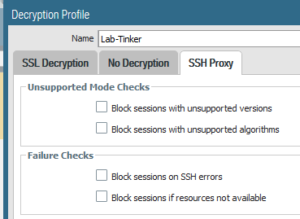

The Palo Alto firewall can be configured to verify the revocation status of certificates used for decryption. user left the organisationĬonfiguring SSL Decryption Certificate Revocation Checking
#Creating an ssh proxy decryption policy install#
The administrator could export and install the self signed certificate to the trusted root certificate store on other devices in order for the self signed certificate to be trusted as a work around. The primary disadvantage is that this self signed certificate would not be trusted by other devices in the organisation. The self signed certificate can also be used with SSL Forward Proxt decryption.
#Creating an ssh proxy decryption policy free#
Import the CA signed certificate from the fileįor self signed certificates, a couple of advantages is that they are free and can be obtained in minutes.Sign and return the certificate in a file.Generate a CSR and public-private keys, export the CSR file.On the last point there with the risk of a key being stolen, there is a workaround: Disadvantage: A small risk that hte private key transferred over the network would be stolen.Import certificate and public-private keys onto the firewall.Create a certificate and public-private keys.Create the certificate and public-private key pair on the CA server.Can be a signing certificate to be used with SSL Forward Proxy decryption.Get a CA-signed certificate and public-private key pair from an internal CA.Limitation in that public CA’s do not sell signing certificates, required for SSL Forward Proxy description.Buy a CA-signed certificate and public-private key pair from a public CA.The administrator has a number of options in obtaining a CA-signed certificate The preferred method for configuration is a CA-signed certificate, which simplifies SSL configuration. The Palo Alto firewall supports two different types of SSL certificate, certificate authority signed certificates and self-signed certificates. The server and client then begin encrypted private communications between each other using the confidential session key.The server uses it’s own private key to decrypt this session key.The client sends an encrypted session key to the SSL server.

The client verifies this SSL certificate against it’s own trusted store of root certificates.The SSL server sends the client it’s server certificate.Client requests an SSL connection to the server.A quick recap on SSL/TLS operationĪn SSL session is established between a client and server as the following: The Palo Alto next generation firewall offers SSL/TLS decryption to help prevent malware introduction through encrypted channels, and data exfiltration out of the company out encrypted channels. It offers many advantages such as encryption for data privacy, hashes for data integrity, and certificates for authentication. Secure Socket Layer / Transport Layer Security secures network communications end to end across a shared network platform. Manage the master key The importantance of SSL/TLS Create and manage certificates using the web interfaceĬonfigure certification revocation checking on the firewallĬonfigure SSL/TLS decryption on the firewallĭescribe the effects of key pinning on firewall Decryption policy


 0 kommentar(er)
0 kommentar(er)
